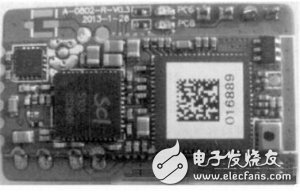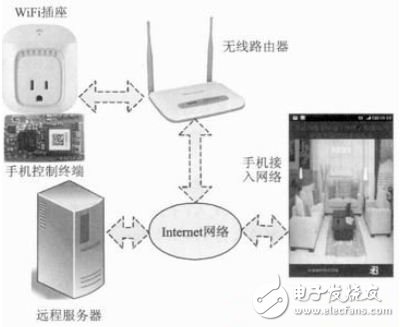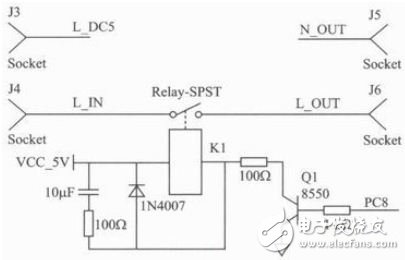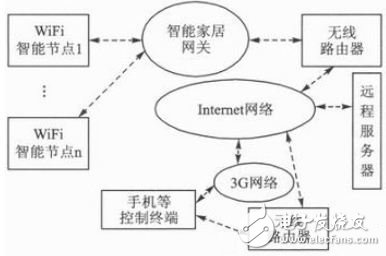Smart home is a residential platform, using integrated wiring technology, network communication technology, security technology, automatic control technology, audio and video technology to integrate home life related facilities, and build efficient management system for residential facilities and family schedules. Home safety, convenience, comfort, and artistry, and achieve an environmentally friendly and energy-saving living environment.
The most commonly used applications are lighting, water heaters, air conditioning, intrusion monitoring, smoke alarms, video surveillance and intelligent control of curtains.
1 Communication technology in smart home
1.1 Comparison of wired communication control and wireless communication control
The communication technology in the smart home can be divided into wired communication technology and wireless communication technology.
(1) Wired control
The structure of the wired control is to place the controller in a strong electric box, and the switch and the central control host are respectively controlled by the weak electric control line. Wired control uses wired communication technology.
Advantages of wired control: safe and stable, undisturbed; shortcomings of wired control: high requirements for the program, high requirements for line erection, and difficulties in later development. This method is used in the early stage of the development of smart homes. It is a change from industrial control. It is mainly used in large-scale commercial places and other places where people have centralized management, and is gradually replaced by wireless communication.
(2) Wireless control
Wireless control uses wireless communication technology to achieve control of the device. Advantages of wireless control: simple installation and wiring; shortcomings of wireless control: anti-interference is worse than wired control, and signal coverage is affected by buildings.
1.2 Wireless communication technology in smart home
The wireless communication technologies in smart homes mainly include:
1 infrared communication technology;
Radio frequency technology less than 1 GHz, such as 2433 MHz;
3 Bluetooth technology;
4ZigBee communication technology;
5Z-Wave technology;
6WiFi technology.
Each technology has its advantages and disadvantages, but regardless of the communication technology used, if you want to achieve remote control of home equipment, the equipment needs to access the Internet. The WiFi communication technology is the mainstream technology for the handheld terminal to access the Internet. Devices that use other communication technologies other than WiFi technology need to be converted by the home gateway to access the Internet. For example, a smart home system using ZigBee technology needs to be in the home gateway. Increase the function of ZigBee to WiFi.
The main advantages of WiFi technology in smart home applications are: WiFi intelligent nodes can directly connect to wireless routers to access the Internet; no need for home gateways, nodes can be arbitrarily expanded; will not destroy existing decoration; smart phones can carry out local area networks Control and remote control.
Of course, WiFi technology has its shortcomings compared to ZigBee and 433 MHz RF communication technology: power consumption is too large and price is high. However, with the introduction of energy-saving technologies and improvements in chip technology, power consumption and price issues have gradually been resolved. Since the WiFi module is a standard configuration for notebooks, tablets, and smart phones, smart homes based on WiFi technology will gradually be promoted and applied, and the market prospect is broad.
The following focuses on the serial WiFi module to illustrate the application of WiFi in smart home.
2 Serial WiFi for use in smart homes
2.1 Serial WiFi Overview
The WiFi module or the WiFi network card used on the computer needs to run on the basis of the operating system, and the hardware resources of the host are very high. For example, the general industrial equipment and the household electrical equipment cannot directly drive such a WiFi network card.
The serial WiFi module, also known as the embedded WiFi module, is a WiFi module with embedded TCP/IP protocol. The hardware component is mainly composed of a built-in single-chip microcomputer and a WiFi module. The single-chip microcomputer must implement the bare-metal driver and TCP/IP protocol, and the WiFi module must complete the wireless transmission and reception of data. The embedded WiFi module provides a UART serial port or an SPI interface, so that it can be connected to the MCU through a serial port or an SPI interface, so that the device can easily access the Internet.
Figure 1 is the SWM9001EU serial WiFi module developed by Lingxin Microelectronics Technology (Suzhou) Co., Ltd. using the WiFi chip of the company's independent intellectual property rights. The module integrates the TCP/IP protocol stack and WiFi module, and the user can easily realize the wireless of the serial device. Network function, saving development time, enabling products to enter the market faster and enhance competitiveness. The module can be widely used in oil fields, mining, industry, smart home and Internet of Things. The mechanical dimensions of the module are 33 mm & TImes; 20 mm & TImes; 4.5 mm.

Figure 1 SWM9001EU serial WiFi module
2.2 SWM9001EU serial WiFi function and indicators
(1) Basic functions
1 single operating voltage is 3.3 V;
2 working current "250 mA (25 mA operating current in energy-saving mode); sleep current "2 mA (Switch off WiFi power);
3CPU clocked at 120MHz, embedded with 256 KB of Flash and SRAM 96 KB;
4 two working modes are command control mode and transparent transmission mode;
5 complete WiFi wireless communication solution to reduce the resource requirements of the application processor;
6 kinds of configuration methods include module built-in WEB configuration server, PC-side configuration software configuration or SCI_AT+ command configuration and mobile phone configuration;
The serial port baud rate is up to 115 200 bps.
(2) WiFi indicator
1 WLAN standard is IEEE802.11b/g, 2.4 G ISM band;
2 support Ad-Hoc mode to set up a wireless network;
3 Support WEP40 and WEP104 encryption (64/128 bit), support WPA/WPA2 PSK encryption, encryption algorithm supports AES and TKIP;
4 WiFi connection is automatically restored after disconnection;
5 The time from reset to the establishment of the WiFi network is less than 5 s (WEP encryption) or 10 s (WPA encryption).
(3) Built-in TCP/IP protocol
1 Support DNS domain name resolution service;
2 Supports DHCP to automatically obtain an IP address, and automatically activates the DHCP server function in Ad-Hoc mode;
3 support network data transmission protocol TCP, UDP;
4 support TCP server mode or client mode;
5 As a TCP client, it has a TCP disconnection automatic reconnection mechanism to ensure stable and reliable data transmission links;
6 as a TCP server, allowing connections of up to 8 clients;
7 supports UDP broadcast or unicast.
The following uses a WiFi socket as a specific example of a serial WiFi module.
3 WiFi socket application in smart home
3.1 WiFi socket application scenarios and system components
These features can be achieved using a WiFi smart socket:
1 Turn on the air conditioner before going home, and you can enjoy the coolness when you return home.
2 Turn on the water heater before going home, and go home to take a hot bath;
3 Start the coffee machine before going home, and go home to drink freshly brewed coffee.
The advantages of WiFi socket: low cost, no need for home gateway; simple installation, no need to break the existing decoration; easy to use, you can expand the number of sockets at will; control is flexible, you can use a smart phone for remote control.
2 is an application system configuration of a WiFi socket, including a WiFi socket, a wireless router, a remote server, a mobile phone control terminal, a mobile phone access network, and an Internet network.

Figure 2 WiFi socket system composition
Take a look at Figure 2 to see how the WiFi socket works:
1 Configure the name (SSID) and key of the router to which the module is to be connected through the configuration procedure on the mobile terminal;
2 Through the configuration program on the mobile terminal, configure the module to connect to the IP address of the remote server;
3 The configuration module is powered on to connect to the remote server.
4 control terminals such as mobile phones connect to the remote server and issue commands;
5 The remote server sends the user command to the WiFi socket in the house;
6 WiFi sockets complete the corresponding on and off actions.
3.2 WiFi socket control principle
The WiFi socket consists of a serial WiFi module, relay control circuit, relay and output contacts, as shown in Figure 3.

Figure 3 The composition of the WiFi socket
The serial WiFi module controls the on and off of the relay according to the received control command. The control circuit is shown in Figure 4.

Figure 4 relay control circuit of WiFi socket
The module receives the closing command, the PC8 port outputs a high level, Q1 is turned on, the relay coil has a current flowing, the relay contact L_IN and the contact L_OUT are attracted, and the socket supplies power to the load;
The module receives the disconnection command, the PC8 port outputs a low level, Q1 is turned off, the relay coil has no current, the relay contact L_IN and the contact L_OUT are disconnected, and the socket is powered off.
The above is just a case of a WiFi socket, and a smart home based on WiFi technology is described. If other functions in the smart home are to be implemented, the implementation principle is similar. For example, to achieve remote video surveillance, simply change the outlet to the camera and implement the appropriate software features.
4 Smart home system based on WiFi technology
The smart home system based on WiFi technology is composed of WiFi intelligent node, smart home gateway, wireless router, remote server, control terminal, 3G communication network and Internet network, as shown in Fig. 5.

Figure 5 WiFi-based smart home system
Conclusion
With the improvement of people's quality of life, the concept of smart home will become more and more popular, and the cost of adopting a full set of smart home systems is very high, and it is still very troublesome for the homes that have already been delivered. With WiFi smart socket, you don't need a home gateway, you can easily realize the intelligent control of home appliances without destroying the existing decoration. You can realize the construction of smart home based on WiFi technology and experience the convenience brought by technology.
Linear Amplifiers Instrumentation OP Amps
Linear Amplifiers Instrumentation Op Amps,Chips Linear Amplifiers Instrumentation,Ic Linear Amplifier Instruments,Linear Amplifiers Instrumentation
Shenzhen Kaixuanye Technology Co., Ltd. , https://www.icoilne.com